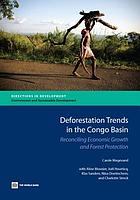
| Judul | Deforestation trends in the congo basin : reconciling economic growth and forest protection / Carole Megevand; Aline Mosnier; Joel Hourticq; Klas Sanders; Nina Doetinchem; Charlotte Streck |
| Pengarang | Megevand, Carole Mosnier, Aline Hourticq, Joel Sanders, Klas Doetinchem, Nina Streck, Charlotte |
| Penerbitan | Washington, D.C. : The World Bank, 2013 |
| Deskripsi Fisik | 179 p. |
| ISBN | 9780821397428 |
| Subjek | BUSINESS & ECONOMICS MICROECONOMICS |
| Catatan | The Congo Basin represents 70 percent of the African continent's forest cover and constitutes a large portion of Africa's biodiversity. The objective of the two-year exercise was to analyze and get a better grasp of the deforestation dynamics in the Basin. The primary goal of the exercise was to give stakeholders (and particularly policy makers) a thorough understanding of how economic activities (agriculture, transport, mining, energy, and logging) could impact the region's forest cover through an in-depth analysis of the connections between economic developments and forest loss. Historically, the Congo Basin forest has been under comparatively little pressure, but there are signs that this situation is likely to change as pressure on the forest and other ecosystems increases. Until very recently, low population density, unrest and war, and low levels of development hampered conversion of forests into other land uses; however, satellite-based monitoring data now show that the annual rates of gross deforestat |
| Bentuk Karya | Tidak ada kode yang sesuai |
| Target Pembaca | Tidak ada kode yang sesuai |
| Lokasi Akses Online |
https://portal.igpublish.com/iglibrary/search/WBB0000104.html |
| No Barcode | No. Panggil | Akses | Lokasi | Ketersediaan |
|---|---|---|---|---|
| 147315292 | 333.750 967 Def | Baca Online | Perpustakaan Pusat - Online Resources Ebook |
Tersedia |
| Tag | Ind1 | Ind2 | Isi |
| 001 | INLIS000000000157401 | ||
| 005 | 20250225113955 | ||
| 007 | ta | ||
| 008 | 250225################|##########|#|## | ||
| 020 | # | # | $a 9780821397428 |
| 035 | # | # | $a 0010-0225000044 |
| 082 | # | # | $a 333.750 967 |
| 084 | # | # | $a 333.750 967 Def |
| 100 | 1 | # | $a Megevand, Carole |
| 245 | 1 | # | $a Deforestation trends in the congo basin : reconciling economic growth and forest protection /$c Carole Megevand; Aline Mosnier; Joel Hourticq; Klas Sanders; Nina Doetinchem; Charlotte Streck |
| 260 | # | # | $a Washington, D.C. :$b The World Bank,$c 2013 |
| 300 | # | # | $a 179 p. |
| 505 | # | # | $a The Congo Basin represents 70 percent of the African continent's forest cover and constitutes a large portion of Africa's biodiversity. The objective of the two-year exercise was to analyze and get a better grasp of the deforestation dynamics in the Basin. The primary goal of the exercise was to give stakeholders (and particularly policy makers) a thorough understanding of how economic activities (agriculture, transport, mining, energy, and logging) could impact the region's forest cover through an in-depth analysis of the connections between economic developments and forest loss. Historically, the Congo Basin forest has been under comparatively little pressure, but there are signs that this situation is likely to change as pressure on the forest and other ecosystems increases. Until very recently, low population density, unrest and war, and low levels of development hampered conversion of forests into other land uses; however, satellite-based monitoring data now show that the annual rates of gross deforestation in the Basin have doubled since 1990. There is indeed some evidence that the Basin forests may be at a turning point of heading to higher deforestation and forest degradation rates. The forest ecosystems have not yet suffered the damage observed in other tropical regions (Amazonia, Southeast Asia) and are quite well preserved. The low deforestation rates mainly result from a combination of such factors as poor infrastructure, low population densities, and political instability that have led to the so-called passive protection. However, signs that the Congo Basin forests could be under increasing pressure from a variety of forces-both internal and external range from mineral extraction, road development, agribusiness, and biofuels to agriculture expansion for subsistence and population growth. All of these factors could drastically amplify the pressure on natural forests in the coming decades and trigger the transition from the 'high forest/low deforestation' profile into a more intense pace of deforestation. |
| 650 | # | # | $a BUSINESS & ECONOMICS |
| 650 | # | # | $a MICROECONOMICS |
| 700 | 1 | # | $a Doetinchem, Nina |
| 700 | 1 | # | $a Hourticq, Joel |
| 700 | 1 | # | $a Mosnier, Aline |
| 700 | 1 | # | $a Sanders, Klas |
| 700 | 1 | # | $a Streck, Charlotte |
| 856 | # | # | $a https://portal.igpublish.com/iglibrary/search/WBB0000104.html |
| 990 | # | # | $a 147315292 |
Content Unduh katalog
Karya Terkait :